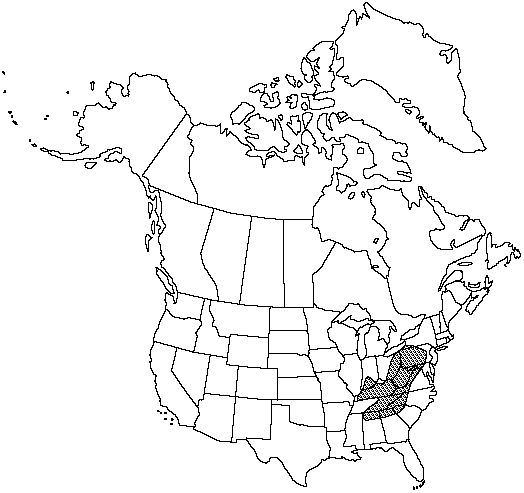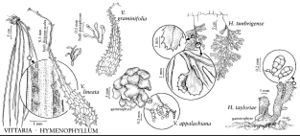Difference between revisions of "Vittaria appalachiana"
Amer. Fern J. 81: 72. 1991.
FNA>Volume Importer |
imported>Volume Importer |
||
| (6 intermediate revisions by 2 users not shown) | |||
| Line 8: | Line 8: | ||
}} | }} | ||
|common_names=Appalachian shoestring fern;Appalachian vittaria | |common_names=Appalachian shoestring fern;Appalachian vittaria | ||
| + | |special_status={{Treatment/ID/Special_status | ||
| + | |code=F | ||
| + | |label=Illustrated | ||
| + | }}{{Treatment/ID/Special_status | ||
| + | |code=E | ||
| + | |label=Endemic | ||
| + | }} | ||
|basionyms= | |basionyms= | ||
|synonyms= | |synonyms= | ||
| Line 23: | Line 30: | ||
|elevation=150–1800 m | |elevation=150–1800 m | ||
|distribution=Ala.;Ga.;Ind.;Ky.;Md.;N.Y.;N.C.;Ohio;Pa.;S.C.;Tenn.;Va.;W.Va. | |distribution=Ala.;Ga.;Ind.;Ky.;Md.;N.Y.;N.C.;Ohio;Pa.;S.C.;Tenn.;Va.;W.Va. | ||
| − | |discussion=<p>Dense colonies of Vittaria appalachiana coat rock surfaces in deeply sheltered habitats throughout the Appalachian Mountains and plateau. Abortive, apogamously produced embryos and small sporophytes with leaves less than 5 mm have been collected from one site in Ohio and have been produced from gametophytes in culture on two occasions. The largest of these produced simple, linear leaves and clathrate rhizome scales typical of Vittariaceae. Starch gel enzyme electrophoresis patterns, as well as morphology, distinguish these plants from other American species. Enzyme electrophoresis patterns and a somatic chromosome number of 120 (G. J. Gastony 1977) suggest that the plants are diploid and possibly of hybrid origin. Fixation of different genotypes in different sections of the range indicates an ancient origin of the independent gametophytes, possibly through Pleistocene elimination of the sporophyte generation (D. R. Farrar 1990).</p><!-- | + | |discussion=<p>Dense colonies of <i>Vittaria appalachiana</i> coat rock surfaces in deeply sheltered habitats throughout the Appalachian Mountains and plateau. Abortive, apogamously produced embryos and small sporophytes with leaves less than 5 mm have been collected from one site in Ohio and have been produced from gametophytes in culture on two occasions. The largest of these produced simple, linear leaves and clathrate rhizome scales typical of Vittariaceae. Starch gel enzyme electrophoresis patterns, as well as morphology, distinguish these plants from other American species. Enzyme electrophoresis patterns and a somatic chromosome number of 120 (G. J. Gastony 1977) suggest that the plants are diploid and possibly of hybrid origin. Fixation of different genotypes in different sections of the range indicates an ancient origin of the independent gametophytes, possibly through Pleistocene elimination of the sporophyte generation (D. R. Farrar 1990).</p><!-- |
| − | --><p>A distinctive morphologic characteristic of Vittaria appalachiana is the variability displayed in gemma production, often including forms intermediate between gemmae and their supporting gemmifer cells and abortive "gemmae" arrested in early stages of development. This is in contrast to the remarkably regular pattern of gemma production in other species (D. R. Farrar 1978; E. S. Sheffield and D. R. Farrar 1988).</p> | + | --><p>A distinctive morphologic characteristic of <i>Vittaria appalachiana</i> is the variability displayed in gemma production, often including forms intermediate between gemmae and their supporting gemmifer cells and abortive "gemmae" arrested in early stages of development. This is in contrast to the remarkably regular pattern of gemma production in other species (D. R. Farrar 1978; E. S. Sheffield and D. R. Farrar 1988).</p> |
|tables= | |tables= | ||
|references= | |references= | ||
| Line 33: | Line 40: | ||
-->{{#Taxon: | -->{{#Taxon: | ||
name=Vittaria appalachiana | name=Vittaria appalachiana | ||
| − | |||
|authority=Farrar & Mickel | |authority=Farrar & Mickel | ||
|rank=species | |rank=species | ||
| Line 46: | Line 52: | ||
|publication title=Amer. Fern J. | |publication title=Amer. Fern J. | ||
|publication year=1991 | |publication year=1991 | ||
| − | |special status= | + | |special status=Illustrated;Endemic |
| − | |source xml=https:// | + | |source xml=https://bitbucket.org/aafc-mbb/fna-data-curation/src/2e0870ddd59836b60bcf96646a41e87ea5a5943a/coarse_grained_fna_xml/V2/V2_13.xml |
|genus=Vittaria | |genus=Vittaria | ||
|species=Vittaria appalachiana | |species=Vittaria appalachiana | ||
Latest revision as of 20:21, 5 November 2020
Plants on rock. Sporophytes absent or abortive, rarely formed (see discussion). Gametophytes sparsely to much branched. Gemmae highly variable, often with end cells swollen; body cells 2–12, rhizoid primordia absent from medial cells, often lacking on 1 or both end cells.
Habitat: In dark moist cavities and rock shelters in noncalcareous rocks. Occasionally epiphytic on tree bases in narrow ravines
Elevation: 150–1800 m
Distribution

Ala., Ga., Ind., Ky., Md., N.Y., N.C., Ohio, Pa., S.C., Tenn., Va., W.Va.
Discussion
Dense colonies of Vittaria appalachiana coat rock surfaces in deeply sheltered habitats throughout the Appalachian Mountains and plateau. Abortive, apogamously produced embryos and small sporophytes with leaves less than 5 mm have been collected from one site in Ohio and have been produced from gametophytes in culture on two occasions. The largest of these produced simple, linear leaves and clathrate rhizome scales typical of Vittariaceae. Starch gel enzyme electrophoresis patterns, as well as morphology, distinguish these plants from other American species. Enzyme electrophoresis patterns and a somatic chromosome number of 120 (G. J. Gastony 1977) suggest that the plants are diploid and possibly of hybrid origin. Fixation of different genotypes in different sections of the range indicates an ancient origin of the independent gametophytes, possibly through Pleistocene elimination of the sporophyte generation (D. R. Farrar 1990).
A distinctive morphologic characteristic of Vittaria appalachiana is the variability displayed in gemma production, often including forms intermediate between gemmae and their supporting gemmifer cells and abortive "gemmae" arrested in early stages of development. This is in contrast to the remarkably regular pattern of gemma production in other species (D. R. Farrar 1978; E. S. Sheffield and D. R. Farrar 1988).
Selected References
None.
